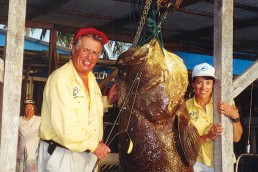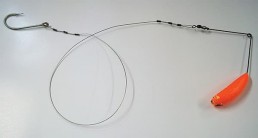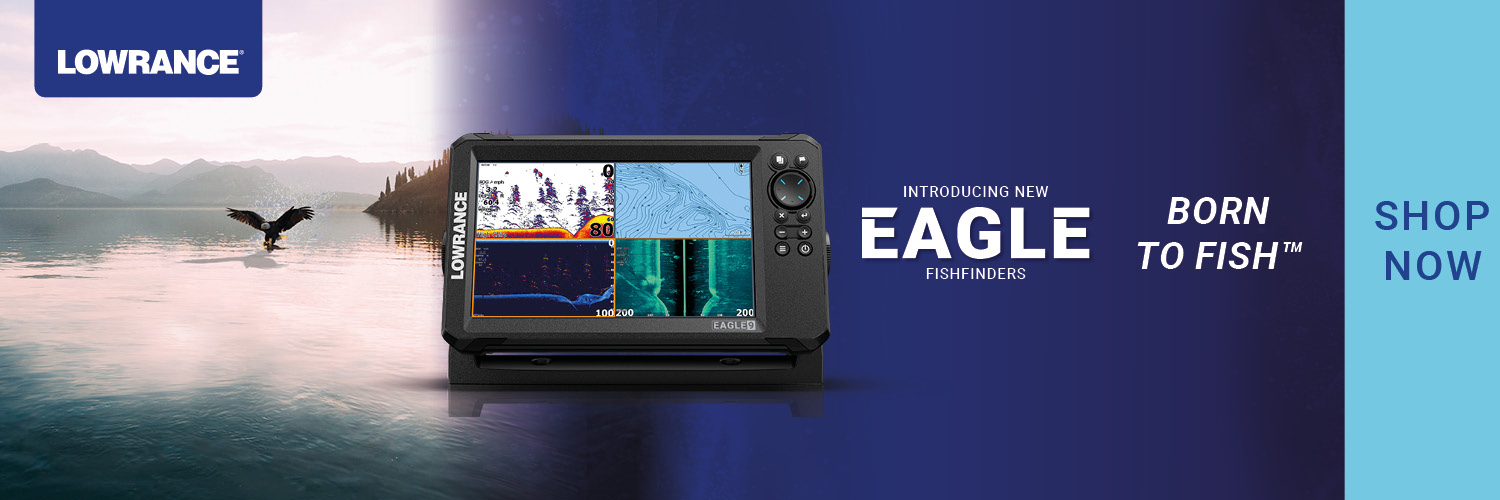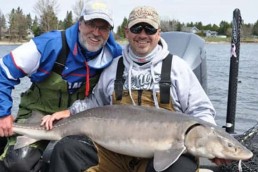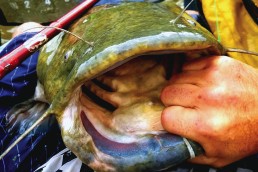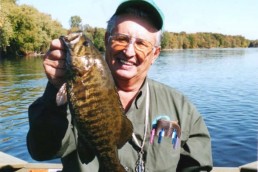Landing Freshwater and Saltwater River Monsters
SHARE THIS POST
It would be a Christmas present for “Bobber” Anne if she were to catch her first tarpon on one December trip to Rio Colorado Lodge in Costa Rica.
Our fishing location on our second day was one-half mile from the Nicaraguan border. We sat at anchor. The temperature was 94 degrees; humidity was high. All around us, sounds from the dense tropical jungle echoed across the river. This was Anne’s first trip into the tropics and she was enthralled.
Her fishing rod was a 7-foot, medium-heavy casting rod with a Garcia medium-sized casting reel loaded with 30-pound-test Dacron line and one of our new experimental 6 1/2-inch Flub Dub lures.
Our guide Henry was in the process of instructing me where to place my Flub Dub so it would run the current without interfering with Anne’s lure, should it be struck. Anne was about to set her rod into one of the rod holders when it was almost jerked out of her hands. As her bass rod doubled, an explosion erupted 50 feet downstream as a huge silver fish went skyward, somersaulted and landed back in the water.
“Tarpon grande!” yelled Henry, as he jumped forward to release the anchor rope’s slip knot, which would cut us loose from the anchor.
This action would allow us to follow the hooked fish. The top of the anchor rope had a huge balloon-style float on it to make retrieving easy.
Again, Anne’s fish exploded skyward, this time 100 feet downstream. At Henry’s instruction, she was in the process of reeling on the rod to set the hook into the monster’s hard mouth. With only one treble hook on the Flub Dub, the chances of losing the fish were high.
But the hook held.
Henry now started the boat’s motor and was trying to catch up. The line on Anne’s reel was getting dreadfully low.
As the 8-foot fish headed downstream to the left shore where dozens of trees lay along shoreline, Henry began calling out on the two-way radio to his fellow guides in the other boats. He asked them to interrupt the fish’s run and get between it and the fallen trees.
It worked. The fish veered back toward the river’s main channel, exploding twice above surface. Next came a race downstream, with Anne holding on for dear life. Perspiration began to cover her.
Again, the fish emerged like a porpoise above water.
Then, it raced away as Anne held on.
“Dan. What do you think? Can I land that monster on this rod and reel?” she asked, as her rod bent to a breaking point.
Knowing my friend, I had no doubt. However, one thing was happening that concerned me: the small Ambassador reel had begun to chatter every time that fish ran.
“Anne. We’ll have to cool off that reel—it appears to be about to seize up. Hold it off to the side,” I instructed, dipping water from the river and pouring it over the reel.
She grinned and kept on.
By now, we’d travelled about 3 miles downstream from point of the hook-up. The monster still had strength in it as it went airborne three more times.
Anne leaned into the fight; the hook held. An hour and thirty minutes had passed. More water was poured on the reel, quieting it. And more long runs downstream came at mid-channel.
Then the runs shortened; it seemed the lady was winning. But darkness would come soon.
One more leap above surface, and a series of short stubborn runs came and there was more water on the reel.
Darkness was now upon us.
Anne’s shirt was now completely wet from the humidity, and the battle between lady and beast moved boat side. Her shoulders were drooping, but a smile was on her face. Finally, after over two hours, the fish rolled at boat side, exhausted from the fight.
Henry helped Anne lift her prize up for photos.
The monster measured 8 feet, 2 inches long, and when compared on the weight chart, it was 243 pounds. This fish would have been a record, but at that time you had to bring the fish in, and this one would have certainly died.
Anne didn’t want to do that.
“Let’s just let it go. She fought a great fight and deserves to live,” Anne said, which I was very proud to hear.
With that, the monster was released, sliding back into the waters of the Rio Colorado River, a gift to the fishing world who’d follow.
The other monster
That wasn’t the only tarpon that I, “Bobber” Anne, have caught and released, but it was certainly the biggest.
Let’s go forward several years, to a brute Dan once caught and kept. No release for this one; it fed the entire native village.
So we were once again on that same river. Dan had taken several goliath grouper near the mouth of the Rio Colorado River, with the biggest right around 200 pounds. But they weren’t big enough for him! He had to tangle with a really huge one.
This urge came to Gapen one morning when he hooked and broke off a huge one. Neither of us, nor our guide, had any idea why the fish was able to cut himself loose. But later, Dan would have the opportunity to see the very fish he’d lost.
A local had taken the monster on a 300-pound-test line. According to the fellow, he’d fought the fish for over an hour as it towed his boat around the river mouth near the village. Finally, he said he was able to gaff it, and with the help of his wife and son, he dragged it into his 24-foot dugout canoe.
The man now waved us down when we passed near him.
“Señor, this must be the fish you lost this morning. Here is your hook and sinker,” he said, as he handed Dan his 10/0 hook and a 10-ounce Bait Walker sinker.
That was all it took.
Dan immediately insisted that we anchor up in the same channel outlet we’d worked earlier at the mouth of the Rio Colorado. This and the San Juan River are two of the rivers goliath grouper migrate up to spawn. There have been incidents when 800-pound grouper have been commercially caught in Lake Nicaragua, their final migration destination. The biggest taken at Rio Colorado was a 670-pound behemoth that tried to eat a young boy as he dove off a commercial dock. The boy was saved by the freight attendant, who pulled him free. We met that boy, who is 50 years old now. He still carries the scars of that encounter on his legs, which had been skinned by the grouper’s teeth. The fish was eventually caught by the freight attendant. He used a leg from a capybara on the line on the dock hoist.
Dan had kept a yellowtail jack from which a huge center-cut chunk was impaled on a 10/0 hook. He held it on the bottom with a 10-ounce Bait Walker. This gory hunk of meat was lowered over the side and dropped to the bottom. With current pressure, the hunk of meat ended up about 20 feet downstream from the boat’s stern. Dan set the rod butt in a rod holder and picked up a tarpon outfit. We’d both cast our Flub Dubs downstream 70 to 80 feet, allowing them to work in the current.
About 25 minutes later, Dan hit a small tarpon and was in the middle of fighting it when Roberto pointed to the meat rod.
Are you enjoying this post?
You can be among the first to get the latest info on where to go, what to use and how to use it!
“Señor—your grouper rod! Look, it moves!”
“Anne, take this rod! I gotta go!”
I obliged and grabbed it. In the ensuing chaos, on the third leap, the tarpon spit the hook.
Dan had lifted the meat rod out of the holder, cranked twice, and then reefed back hard three times. That was enough to anger whatever was on the other end because it sped off like a bus.
Line ripped off the reel so much so that my partner expressed doubt he had enough line to stop the beast.
“Guys, the only thing I know to do is take the drag off and see if the lessening of drag pressure will help stop its run and come back upstream,” commented my partner Dan, who was now puffing.
It was an old trick Dan had learned while he was fishing river salmon years back.
“No! No, señor! You will lose her—she is grande!” Roberto excitedly remarked.
By this time, the drag had been dropped off completely and Dan was busy reeling in loose line. Next, reel drag was increased.
“Oh, señor—you lose her,” Roberto said sadly, as Dan continued to fast-reel.
Fifty winds of the reel handle put substantial line back onto the reel.
“No, gang—I believe she’s still on there,” Dan said, confidently. “She’s just racing back up here to where she was hooked.”
Sure enough, as line was wrapped back on the Garcia 7000, the custom-made Grandt rod began to bend in an arch. Suddenly, it was calculated that Dan’s monster was only 10 feet behind the boat, 12 feet below the surface.
Then the real battle began!
Dan seemed pretty excited about it all. He hauled on the bottom-hugging fish, but to no avail. What was down there, a vault door?
Lifting hard on the rod did absolutely nothing. I considered the strength of the man, and that of the fish.
How would this end? Knowing the grit of my friend, I had high hopes.
Then, with a lift of the rod he was able to gain a few winds of the reel, then a few more. What was this fishing doing? Was it coming to surface? It had zipped crosscurrent for a ways, and then kept going to the other side of the boat.
Dan’s rod was now jerked hard to the left.
“I’m going to need that chair, Anne! I think this beast is right under you!”
I jumped out and let him work his way to my boat seat; he reefed hard all the way.
“Do you think you can make some headways on him!?” I asked.
“ … Hoping so!” Dan exclaimed.
This went on for a long time. The fish was speeding back and forth, moving downstream from the boat. Dan would gain line whenever he could.
Roberto alternately looked hopeful, but then doubtful—after all, his client was 68 years old. He knew there was a really big fish down there, and he wanted Dan to catch it in the worst way.
“You can do it, señor!” he encouraged.
The tussle was nearing the two-hour mark by now. The give and take between man and fish was almost equal. We switched seats several times as the behemoth zigzagged behind and under the boat.
I poured cool water in Dan’s mouth to replace what he was sweating out in the humid, tropical heat. Sometimes I had to swab water on his forehead to keep him from overheating.
The tug-of-war was at two hours now, and Dan was showing signs of tiring. Apparently, the fish was tiring too, as more line was gained on the reel. If Dan could just hang in there he could get this beast in. And now we had noticed that more of the battle was directly under the boat—a good sign.
A while later, we got our first look at the beast. Just like a submarine, it emerged to surface. Through the fight, six to eight boats had stopped by to watch, curious to see what was actually on.
A gasp went up when we saw that huge grouper; it looked like an alien. General consensus was that it weighed around 200 pounds. It made a few more attempts at fighting, then lay nearly subdued alongside the boat. Roberto grabbed our anchor rope, leaned over the gunwale and ran the rope through its mouth and out the gills. He tied it to the aluminum handrail on the boat. Seconds later, the monster rolled and thrashed its tail, tearing loose the rail. Everyone scrambled to grab hold of the rope so it wouldn’t get away. The total fight time finally ended at three hours, 30 minutes.
“We can’t get this thing under control in this current! Could you tow it upstream to that quiet eddy?” Dan asked our guide.
Roberto agreed that that was the only way. He started the motor and slowly chugged up to the eddy. Here, she was secured by rope.
Because grouper down here are so highly prized for food, it was going to be kept. But they couldn’t just put it in the boat while it was alive because if it thrashed it would smash everything in its way, including humans. So they subdued it with heavy wooden clubs. Next, it took three guides to roll it over the edge into the boat. Back to the camp we went.
Once there, the only way to get Dan’s prize out of the boat was to hook it to a block-and-tackle pulley system used to lift boat motors out for repair. The weight registered was at 309 1/2 pounds! After lowering it flat onto the deck, the guys took a 3-foot machete and sawed the skin off. It was filleted into big chunks, each about the size of a 20-pound turkey, and each guide got to take one home. The balance was distributed to the rest of the people of the village so it literally fed the residents of Rio Colorado.
Dan was exhausted, but also happy, having caught the fish of his dreams.
Ones for the ‘record’
Had there had been a category for a 40-pound-test line, my fish, in the latter story, would have qualified as a world record. Likewise, “Bobber” Anne’s fish in the first run in the Rio Colorado would have been as well.
Anne’s chance came two years later when she landed a grouper estimated at 272 pounds. We were fishing with Dale Rothstein of Chicago, who thought it was bigger than mine, but measurements proved otherwise.
MWO
SHARE THIS POST
Did you enjoy this post?
You can be among the first to get the latest info on where to go, what to use and how to use it!
Dan Gapen
Considered one of the world’s leading river anglers, Dan Gapen, Sr. has shared his knowledge with MidWest Outdoors readers and viewers for more than 40 years. He is a member of all three Fishing Halls of Fame—International, National Freshwater, and Minnesota. He has an immense grasp of the world’s fisheries. He may be contacted at 877-623-2099.
@TheGapenCompany.

